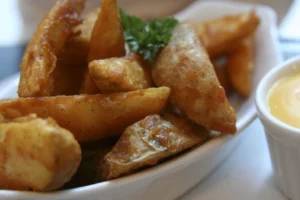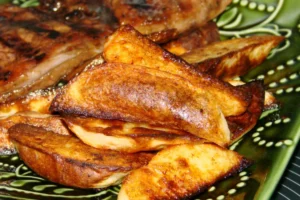Understanding the Basics
Why Crispiness Eludes Many

For many home cooks, the journey to crispy wedges is fraught with soggy outcomes. It turns out, several factors play pivotal roles in achieving that coveted crunch. Firstly, not all potatoes are created equal when it comes to frying or baking. High-starch varieties like Russets and Yukon Golds are often heralded as the best picks due to their ability to crisp up beautifully.
Moreover, many folks skip a crucial step: soaking the potatoes. This process is essential as it removes excess starch, which can otherwise trap moisture and prevent your wedges from crisping up. So next time, before you rush your wedges into the oven or fryer, let them lounge in some cold water for a bit.
Choosing the Right Potatoes
Choosing the right type of potato is the first step towards wedge perfection. Look for potatoes with a high starch content, such as Russets or Yukon Golds. These varieties not only hold their shape well but also have the ideal texture that crisps up wonderfully when cooked.
Avoid waxy potatoes like Reds or Fingerlings for making wedges, as they tend to become soft and chewy rather than crisp. Remember, the right potato can make all the difference between a crispy delight and a floppy letdown.
By understanding these basic principles, you’re already on your way to achieving crispy, delicious wedges every time. Stay tuned for more insights in the next sections, where we’ll delve into preparation techniques that elevate your wedges from mundane to magnificent.
Preparing Your Wedges
Cutting Techniques for Perfect Wedges
The journey to the perfect crispy wedge begins with how you cut your potatoes. Precision in slicing not only ensures even cooking but also impacts how well your wedges will crisp up. Aim to cut your wedges uniformly—about half an inch thick at the widest part. This size is ideal as it provides enough surface area for the crispiness to develop while ensuring the inside remains fluffy and soft.
Start by cutting your potato in half lengthwise, then slice each half into three or four wedges, depending on the size of the potato. Consistency is key; uneven wedges won’t cook uniformly, leaving you with some parts overdone and others undercooked.
The Importance of Soaking
Soaking your potato wedges is more than just a preparatory step; it’s a game-changer. By immersing cut potatoes in cold water for at least an hour—or even overnight if you plan ahead—you strip away excess starch that can inhibit crispiness. This process also helps in preventing the wedges from sticking together or to the baking sheet.
After soaking, it’s crucial to dry your wedges thoroughly with a clean kitchen towel or paper towels. Any lingering moisture can steam the potatoes during cooking, sabotaging their crispiness. Make sure they’re bone dry before proceeding to the next step.
Equipped with these preparation techniques, your wedges are now primed for the ultimate transformation. As we move on to the cooking methods in the next part, you’ll see how a few key adjustments can make all the difference in achieving that perfect golden crust you’re aiming for.
Cooking Techniques
Baking vs. Frying: Which Is Better?
When it comes to cooking your wedges, you have two main options: baking or frying. Each method offers its own set of advantages for achieving crispy perfection.
Baking is often seen as the healthier alternative. To get the most out of this method, preheat your oven to a high temperature—around 425 degrees Fahrenheit (220 degrees Celsius). This high heat is crucial as it quickly forms a crust on the wedges, which seals in moisture and creates a crispy exterior. Before baking, toss your dried wedges in a light coating of oil and your favorite seasonings. Spread them in a single layer on a baking sheet, ensuring they don’t touch, which helps avoid steam that can make them soggy.
Frying, on the other hand, is the traditional route for those who crave an extra crunch. The key to frying is to use the right oil—such as canola or vegetable oil—that can withstand high temperatures without burning. Heat the oil to around 350 degrees Fahrenheit (175 degrees Celsius) before adding your wedges. Don’t overcrowd the pan, as this can lower the temperature of the oil and lead to less crispy results. Fry the wedges until they’re golden brown and float to the surface, then drain them on paper towels to remove excess oil.
Optimal Cooking Temperatures and Times
Whether you choose to bake or fry, controlling the temperature and timing is essential for achieving crispy wedges. For baking, keep your oven hot and bake for about 25-30 minutes, flipping the wedges halfway through to ensure even crispiness on all sides. For frying, maintain your oil’s heat at a steady medium-high to avoid under or overcooking the potatoes.
In both methods, it’s important not to rush the cooking process. Giving your wedges enough time at the right temperature allows them to develop a crisp exterior while ensuring the inside remains soft and fluffy.
By mastering these cooking techniques, you’re well on your way to serving up perfectly crispy wedges that are sure to impress. Up next, we’ll explore some advanced seasoning and troubleshooting tips to further enhance your wedge-making skills.
Advanced Tips and Tricks

Seasoning Secrets for Flavorful Wedges
To elevate your wedges from good to irresistible, it’s all about the seasoning. Before cooking, consider tossing your dried and cut wedges in a mixture of oil and a blend of spices. Classic choices like salt, pepper, and garlic powder are staples, but don’t shy away from experimenting with other flavors such as smoked paprika, cayenne for a kick, or herbs like rosemary and thyme for a savory touch.
For those looking to keep things interesting, try incorporating a sprinkle of parmesan cheese or nutritional yeast into your seasoning mix for an added layer of flavor that crisps up beautifully in the oven. Always remember to coat your wedges evenly to ensure every bite is as delicious as the last.
Troubleshooting Common Issues
Even with the best preparations, sometimes things don’t go as planned. Here are some tips to troubleshoot common wedge-making issues:
- Wedges Sticking to the Pan: To avoid this, make sure your baking sheet is well-greased and your wedges are thoroughly dried. You can also use parchment paper as a non-stick surface to make flipping easier and cleanup a breeze.
- Uneven Cooking: Consistency in size and thickness is crucial for even cooking. Use a sharp knife to achieve uniform cuts and arrange your wedges in a single layer without overcrowding.
- Lack of Crispiness: If your wedges aren’t crisping up, consider increasing the oven temperature slightly or extending the cooking time a bit. Just keep a close eye on them to avoid burning.
By implementing these advanced tips and troubleshooting common pitfalls, your wedges will not only taste great but also achieve that perfect crispy texture. With these skills now under your belt, you’re ready to turn simple potatoes into a standout dish that will wow your family and guests alike.
FOR MORE RECIPE CLICK HERE

